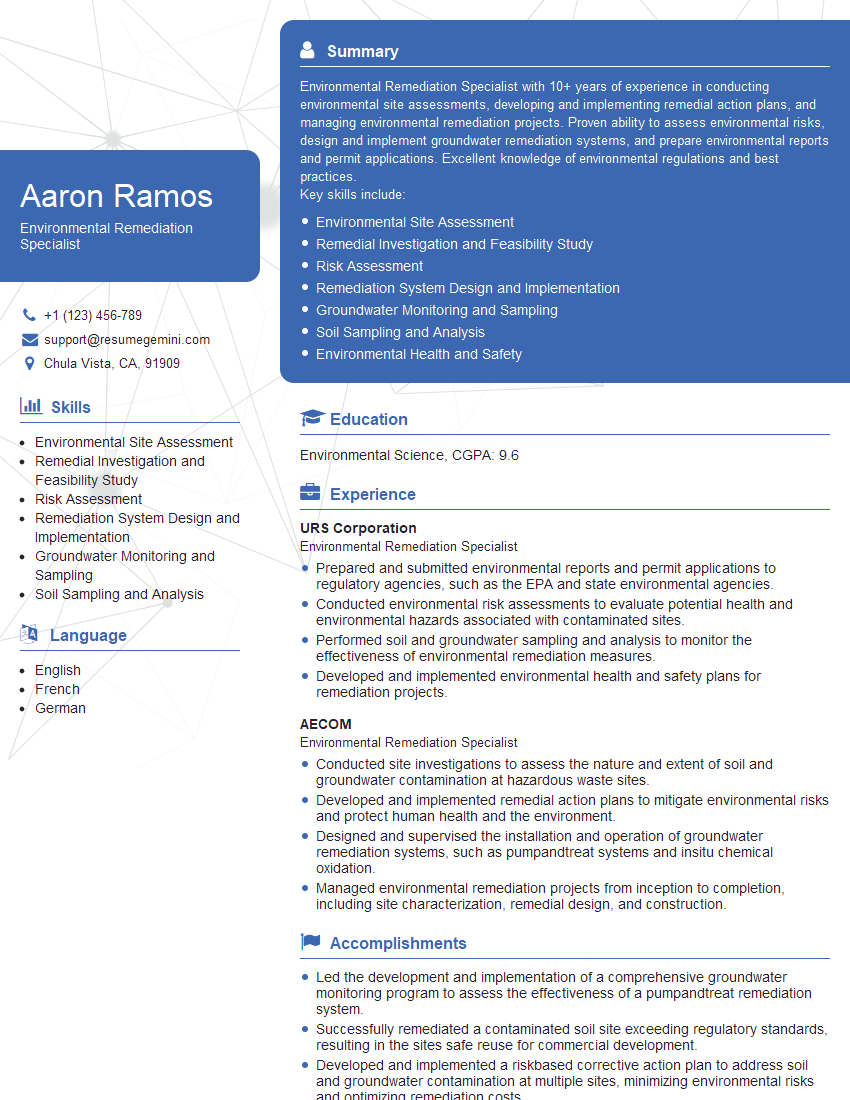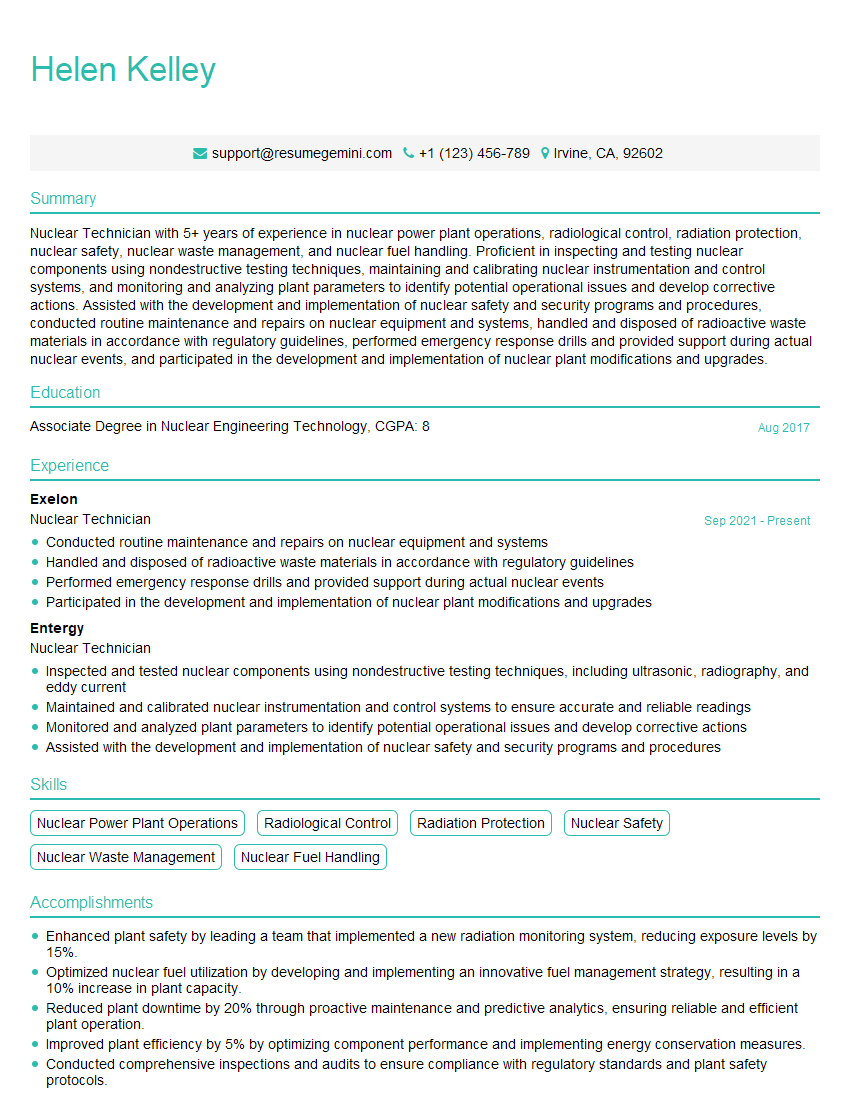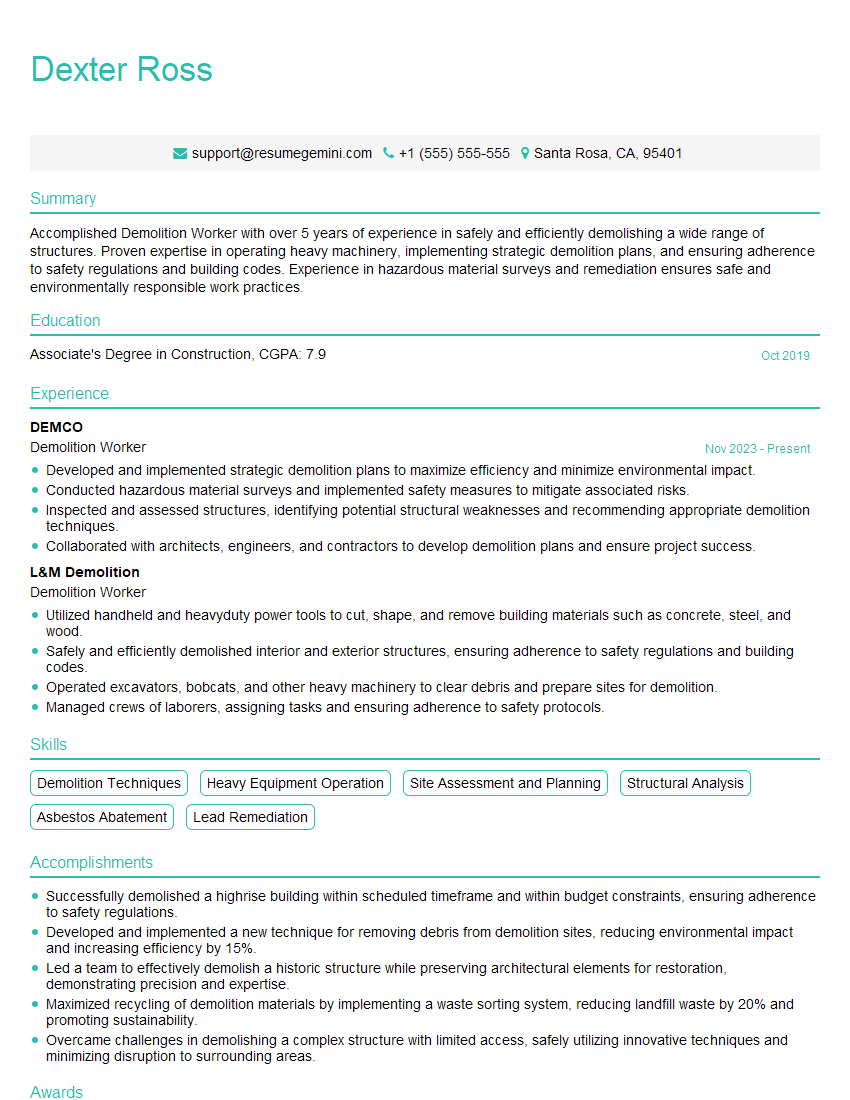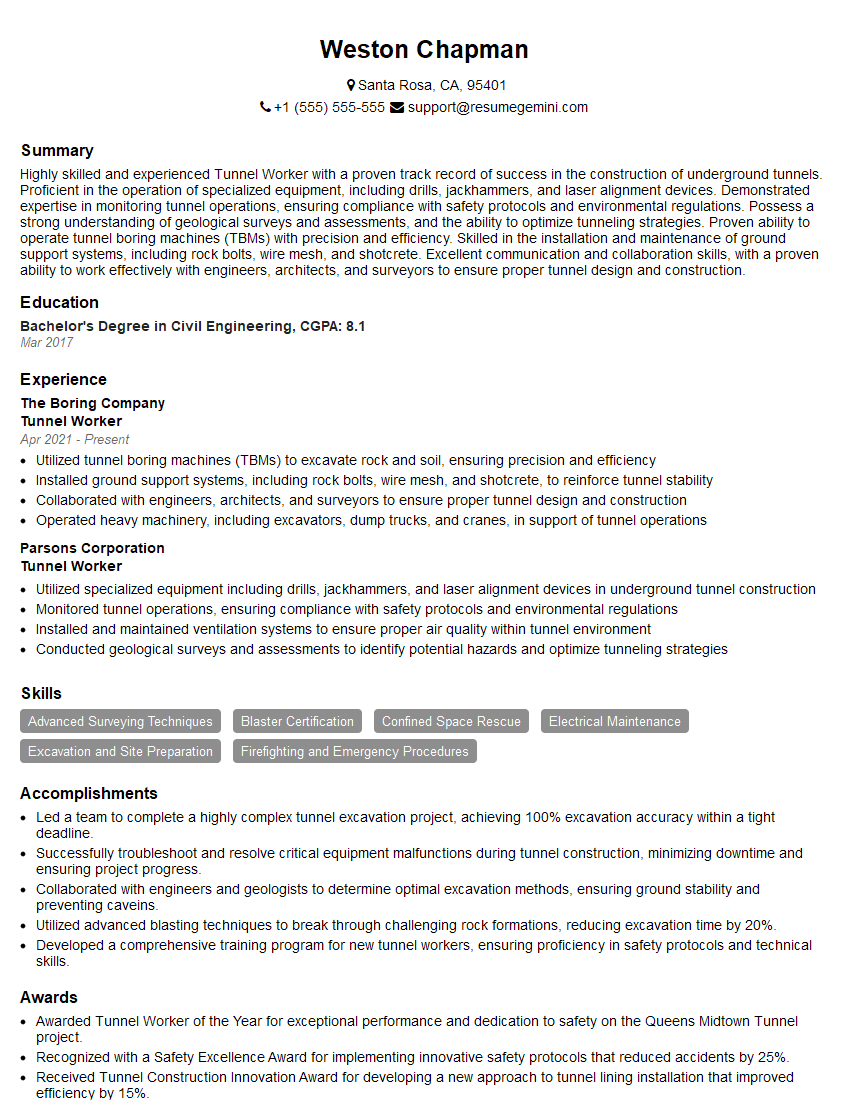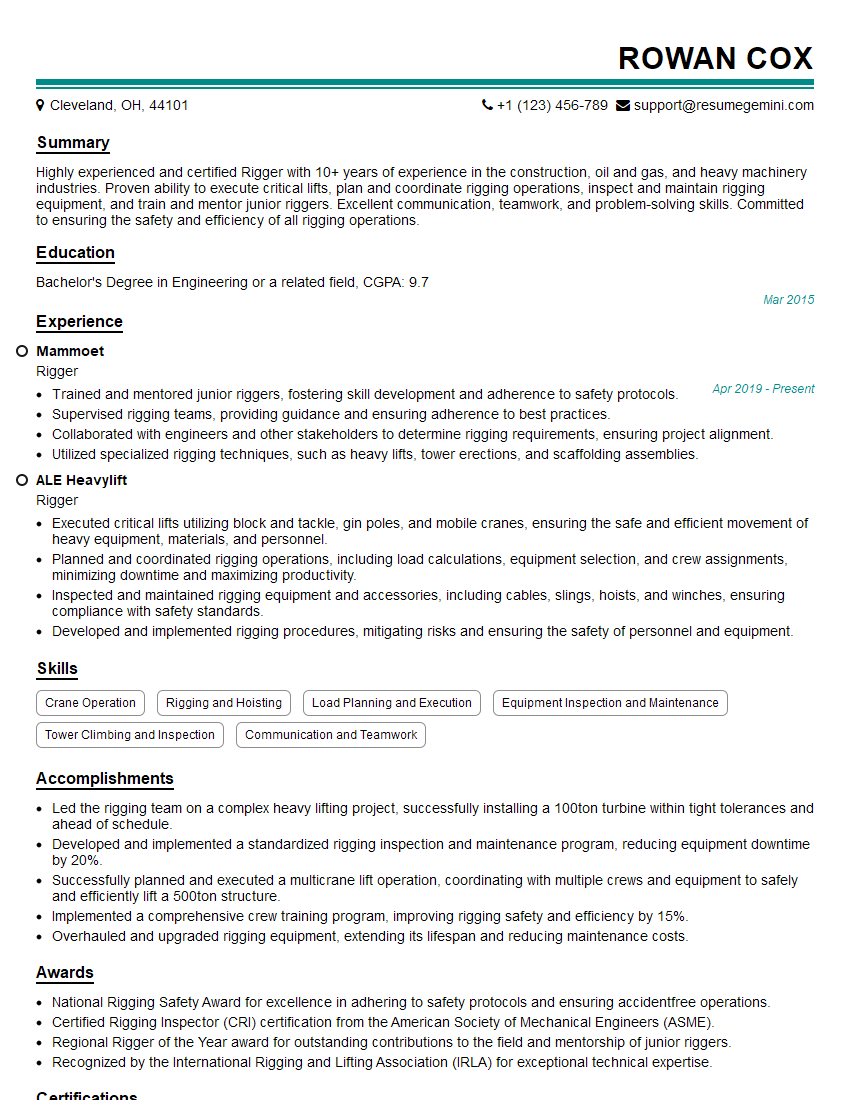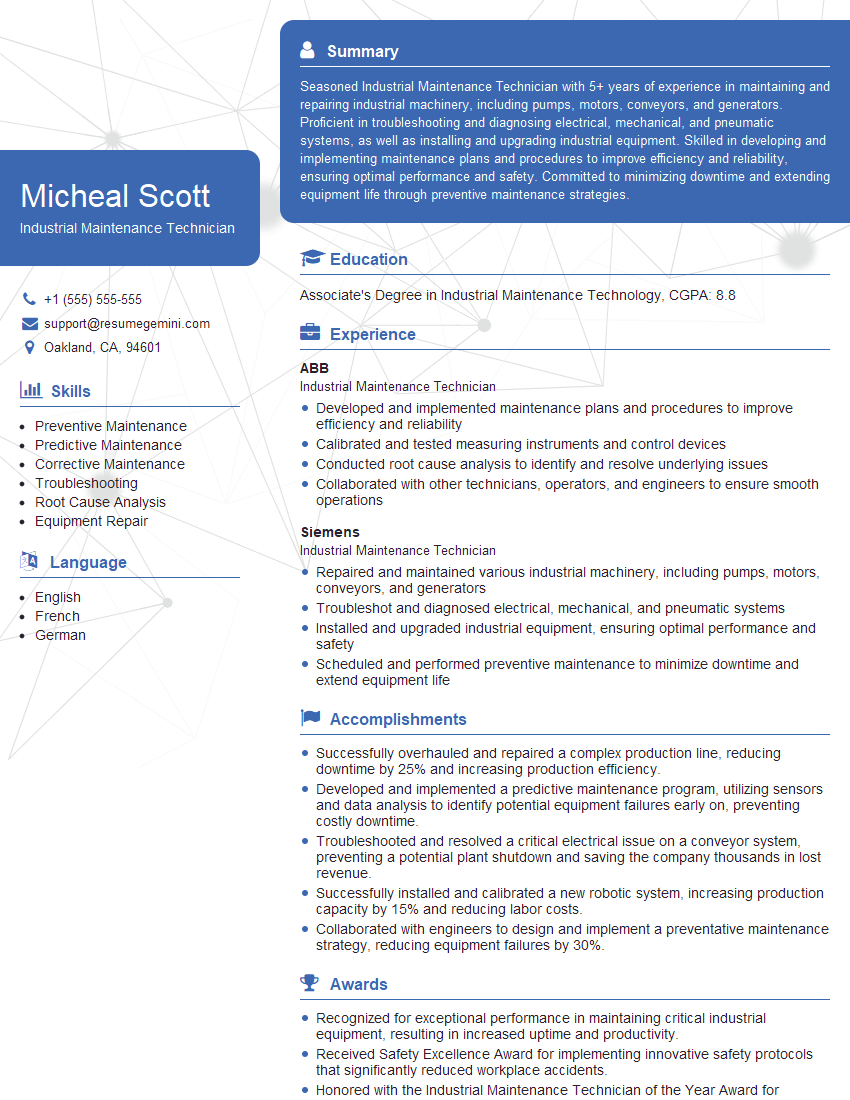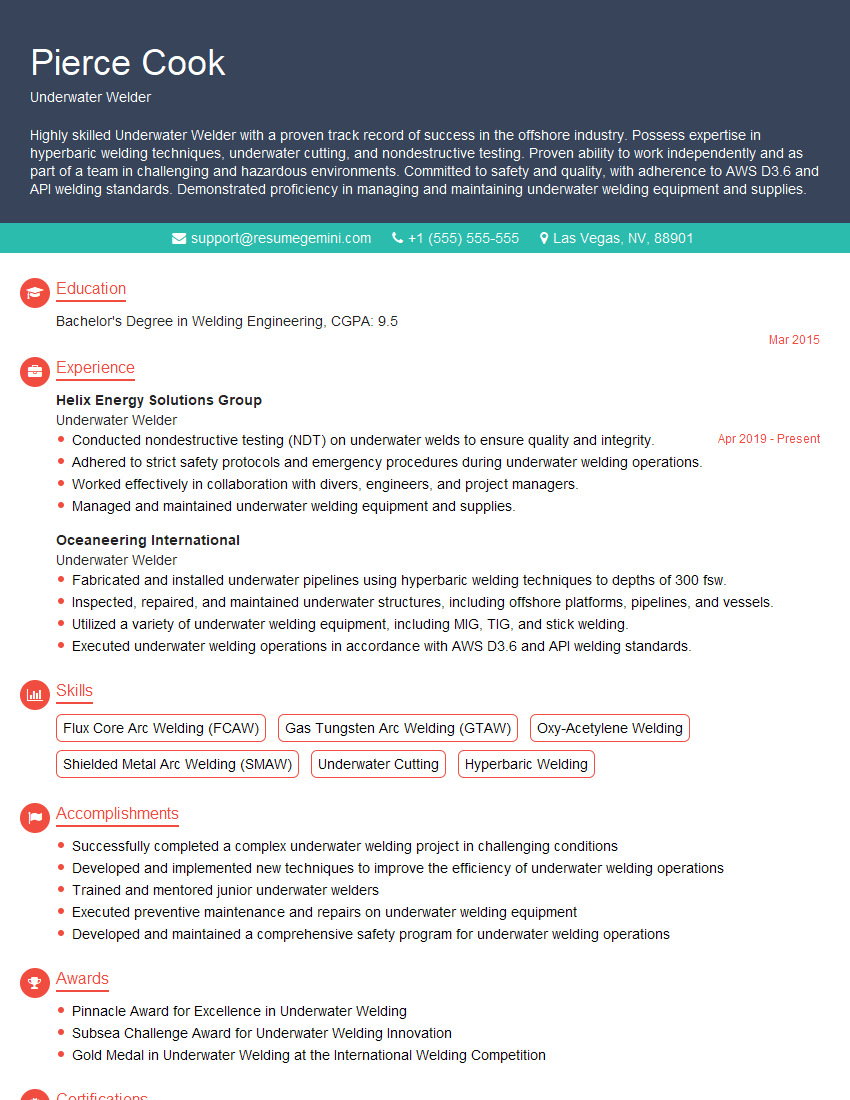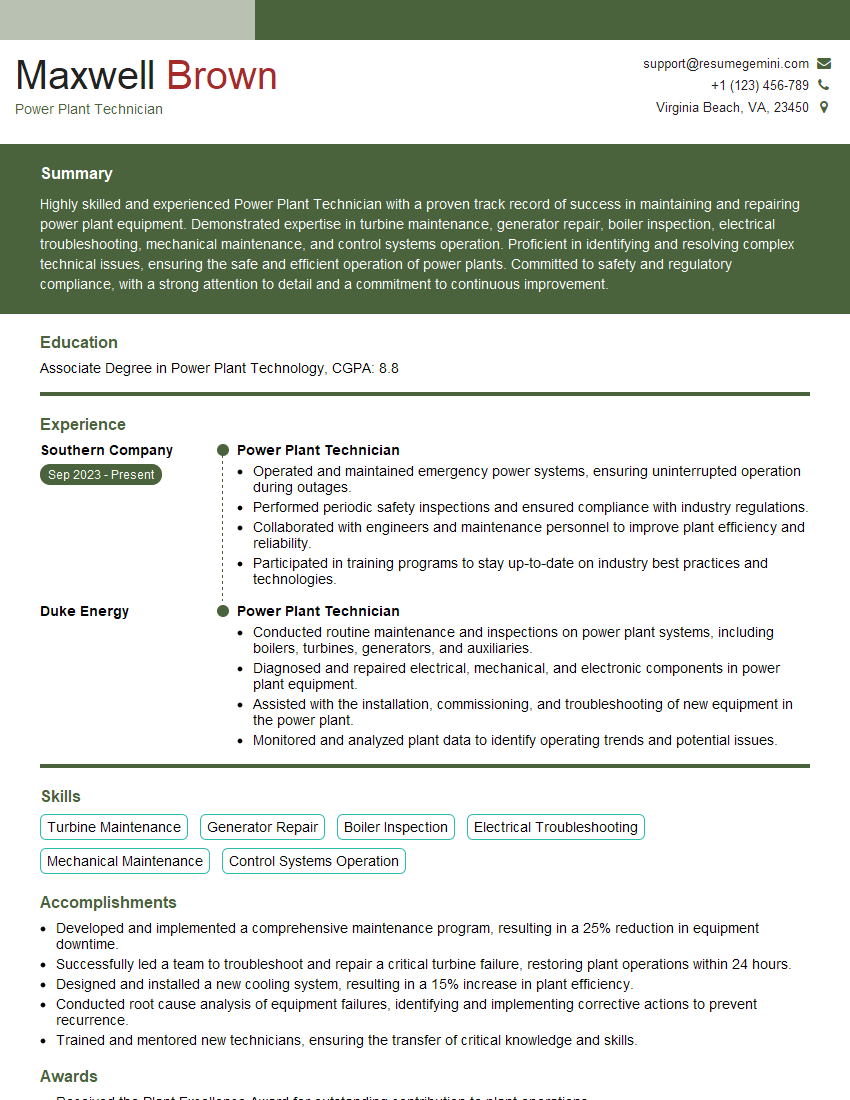Feeling uncertain about what to expect in your upcoming interview? We’ve got you covered! This blog highlights the most important Excellent maneuvering skills in confined spaces and hazardous conditions interview questions and provides actionable advice to help you stand out as the ideal candidate. Let’s pave the way for your success.
Questions Asked in Excellent maneuvering skills in confined spaces and hazardous conditions Interview
Q 1. Describe your experience with confined space entry procedures.
Confined space entry procedures are meticulously defined protocols designed to ensure worker safety in enclosed areas with limited access and potential hazards. These procedures are not merely checklists; they are a systematic approach to risk mitigation, prioritizing safe entry, work execution, and emergency response. My experience encompasses years of working with various industries, including petrochemical, manufacturing, and utilities, where I’ve consistently followed and, in many cases, helped to develop and implement, these procedures. A typical procedure involves:
- Permit-to-Work System: A crucial step, this involves a thorough risk assessment, atmospheric testing, and the authorization of entry by a competent person. The permit documents all identified hazards, control measures, and emergency contacts.
- Atmospheric Monitoring: Before, during, and after entry, the atmosphere is rigorously checked for oxygen levels, flammable gases, and toxic substances. I’m proficient in using various gas detection instruments.
- Lockout/Tagout: Energy isolation procedures are vital to prevent accidental energization of equipment.
- Entry and Rescue Plan: A detailed plan is developed in advance, outlining procedures for entry, work tasks, communication, and emergency rescue. This always includes a designated standby person and readily available rescue equipment.
- Post-Entry Inspection: After the work is complete, a final inspection ensures all equipment is secured and the space is safe for exit.
I’ve personally overseen hundreds of confined space entries, ensuring strict adherence to these protocols. For example, during a recent project involving tank cleaning, my team successfully used the permit-to-work system to identify and mitigate the risk of hydrogen sulfide exposure, resulting in a safe and efficient completion of the task.
Q 2. What are the common hazards associated with confined spaces?
Confined spaces harbor numerous potential hazards, broadly categorized as atmospheric, physical, and biological.
- Atmospheric Hazards: These are the most significant threat and include oxygen deficiency (leading to asphyxiation), the presence of flammable or explosive gases (methane, propane, etc.), and toxic gases (hydrogen sulfide, carbon monoxide, etc.).
- Physical Hazards: These can be engulfment (being submerged in liquids or solids), falls, entrapment, crushing, and electrical hazards. The confined nature of the space amplifies the danger of these hazards.
- Biological Hazards: These can include bacteria, viruses, fungi, or other biological agents, depending on the nature of the confined space. Examples include mold growth in poorly ventilated areas or exposure to pathogens in sewage systems.
It is crucial to remember that these hazards are not mutually exclusive; a confined space can simultaneously pose multiple threats. For instance, a sewer maintenance task might involve exposure to toxic gases (biological and atmospheric), risk of engulfment (physical), and exposure to pathogens (biological).
Q 3. Explain the importance of atmospheric monitoring in confined spaces.
Atmospheric monitoring is paramount in confined space entry because it directly addresses the most immediate and life-threatening hazards. Without it, workers are essentially entering a potentially lethal environment blind. Monitoring allows us to detect the presence of harmful gases, vapors, and oxygen deficiency before entry, and continually during the entire duration of the work.
Regular monitoring allows us to make informed decisions based on real-time data. If the oxygen level drops below a safe threshold, or if flammable or toxic gases are detected, the entry can be immediately halted, and corrective actions undertaken before any harm occurs. For example, I’ve used readings from gas detectors to determine the need for using positive pressure SCBA (self-contained breathing apparatus) or implementing ventilation strategies to improve the atmosphere.
Moreover, post-entry monitoring provides a record of the atmospheric conditions experienced by the workers, essential for post-incident investigations and demonstrating compliance with safety regulations. The data gathered is crucial to identifying and correcting any potential deficiencies in the existing safety protocols.
Q 4. How do you assess the risks associated with a specific confined space?
Risk assessment in a confined space is a systematic process, involving a detailed evaluation of all potential hazards and the likelihood of their occurrence. It’s not a one-size-fits-all approach; each space requires a specific and customized assessment.
My approach involves a five-step process:
- Identification of Hazards: A thorough inspection of the space, considering all potential atmospheric, physical, and biological hazards.
- Risk Evaluation: Determining the likelihood and severity of each identified hazard. This may involve using qualitative or quantitative methods.
- Control Measures: Developing and implementing control measures to mitigate the identified risks. This might include ventilation, gas monitoring, PPE, or even prohibiting entry altogether if the risks are deemed unacceptable.
- Emergency Planning: Developing an emergency response plan which outlines procedures for rescue, evacuation, and first aid.
- Documentation: All findings, control measures, and the overall risk assessment should be comprehensively documented for record-keeping and traceability.
For example, while assessing a sewage manhole, the potential hazards would include oxygen deficiency, hydrogen sulfide, engulfment, and biological hazards. My risk assessment would prioritize ventilation measures to reduce the concentration of hazardous gases and provide appropriate PPE to protect against biological hazards and potential engulfment. I would always ensure a detailed rescue plan is in place before commencement of any work.
Q 5. What personal protective equipment (PPE) is required for confined space entry?
Personal Protective Equipment (PPE) for confined space entry is dictated by the specific hazards identified in the risk assessment. It must always be appropriate for the task and must be regularly inspected and maintained to ensure its effectiveness. Minimum PPE usually includes:
- Self-Contained Breathing Apparatus (SCBA): This is essential to provide a breathable atmosphere when working in environments with oxygen deficiency or toxic gases.
- Hard Hat: Protection against falling objects.
- High-Visibility Clothing: Enhanced visibility within the confined space.
- Protective Gloves: Chemical-resistant gloves are often needed to protect against hazardous materials.
- Coveralls or Protective Suit: To protect against splashes or other contaminations.
- Safety Harness and Lifeline: For fall protection and rescue.
- Appropriate Footwear: Steel-toe boots or other protective footwear are essential.
The selection of PPE is never arbitrary. It is critical to take into account factors such as chemical resistance, impact resistance, and the overall level of protection required based on the specific hazards of the confined space.
Q 6. Describe your experience with using breathing apparatus in confined spaces.
My experience with breathing apparatus in confined spaces is extensive, encompassing various types of SCBA and supplied-air respirators (SARs). I’m proficient in their use, inspection, and maintenance, holding certifications in respiratory protection, demonstrating my mastery of proper fit testing and equipment management.
Before each entry, I meticulously inspect the SCBA, ensuring its air supply, pressure gauge, and other critical components are functioning correctly. I understand the importance of proper donning and doffing techniques, as well as emergency procedures in case of equipment malfunction. I’ve also trained extensively on the limitations of different types of breathing apparatus, understanding that using the incorrect equipment can be as dangerous as not having any at all.
In one instance, while working in a chemical storage tank, a malfunction in a colleague’s SCBA triggered an emergency. My swift response in managing the situation using the emergency procedures allowed for a safe retrieval, highlighting the importance of regular training and preparedness. I am very familiar with the differences between positive pressure and negative pressure respirators and when each is best utilized.
Q 7. Explain the procedures for rescue in a confined space emergency.
Confined space rescue procedures are critical components of any entry plan and should be rigorously rehearsed. These procedures prioritize the safety of both the trapped worker and the rescuers. The approach is always based on the “three-in, three-out” principle: always have three people ready for entry, while three more remain outside and manage the situation.
The procedures typically involve the following steps:
- Alerting Emergency Services: Immediately calling emergency services and providing them with the precise location and the nature of the emergency.
- Standby Person Monitoring: The standby person at the entrance continuously monitors the worker inside, communicating regularly via pre-arranged signals. If a failure to communicate occurs, rescue procedures are immediately initiated.
- Rescue Attempt: If the trapped worker is conscious and able to communicate, rescue efforts may involve assisting them out. If unconscious, it’s likely more complex.
- Emergency Retrieval: Using appropriate rescue equipment, such as harnesses, winches, and retrieval systems, as well as the assistance of additional rescue personnel.
- Post-Rescue Care: Providing immediate first aid and medical attention to the rescued individual.
- Investigation: A comprehensive investigation is conducted to determine the cause of the incident and implement corrective measures to prevent similar incidents in the future.
These procedures must be meticulously planned and regularly practiced. We regularly conduct simulated rescues to ensure that everyone is prepared to respond effectively in a real-life emergency situation. The ultimate objective is always to minimize injuries and ensure the swift and safe rescue of the trapped individual.
Q 8. What are the different types of confined space entry permits?
Confined space entry permits are crucial safety documents authorizing entry into hazardous areas. Their specifics vary by organization and regulatory requirements, but generally include:
- Hot Work Permit: Used for activities involving fire or sparks, requiring extra precautions against flammable atmospheres.
- Cold Work Permit: Covers non-ignition-related tasks, focusing on other hazards like confined space atmosphere testing and fall protection.
- Emergency Entry Permit: Used for urgent rescue situations, often bypassing some standard procedures (but never safety protocols).
- Specific Task Permits: Permits tailored to specialized tasks within the confined space, outlining unique hazards and controls.
For example, a hot work permit would require detailed checks for flammable gases before welding begins in a tank, whereas a cold work permit might focus on ensuring sufficient ventilation before entering a sewer to conduct inspections. The permit serves as a record of the risk assessment and the controls implemented.
Q 9. How do you ensure effective communication during confined space operations?
Effective communication in confined space operations is paramount, as it’s easy for accidents to occur unnoticed or for workers to become incapacitated. We utilize a multi-faceted approach:
- Dedicated Communication Channels: Using two-way radios with clear, designated channels for both entry and surface personnel. This avoids confusion with other site communications.
- Visual Signals: Implementing clear hand signals or pre-arranged light systems to communicate even when radios fail. This is especially important in noisy environments.
- Regular Check-ins: Establishing fixed intervals for communication, ensuring that both surface and entry teams are maintaining contact.
- Emergency Procedures Broadcast: All personnel are trained to understand specific emergency codes and phrases that trigger immediate responses.
- Detailed Communication Logs: Maintaining detailed records of all communications, including time stamps and the nature of the messages. This is valuable for incident investigation.
In one instance, a sudden drop in oxygen levels was immediately detected via the atmospheric monitoring equipment and communicated via radio, allowing for a swift and controlled evacuation of the confined space, preventing injury.
Q 10. Describe your experience with confined space ventilation.
Confined space ventilation is crucial to eliminate or reduce hazardous atmospheres. My experience includes working with different ventilation methods, including:
- Mechanical Ventilation: Using blowers and exhaust fans to introduce fresh air and remove contaminated air. This involves careful selection of fan type and capacity to suit the specific confined space and hazard.
- Natural Ventilation: Utilizing natural air currents and openings to provide ventilation. This is less effective and often requires supplemental mechanical ventilation.
- Positive Pressure Ventilation: Introducing fresh air at a rate exceeding the air leakage, preventing hazardous gases from entering.
- Negative Pressure Ventilation: Extracting air from the confined space, which may be necessary to control the spread of hazardous substances.
I have experience assessing the effectiveness of ventilation by conducting atmospheric monitoring before, during, and after work in the confined space. For example, in a large storage tank, we used a combination of positive-pressure ventilation to displace flammable vapors and atmospheric monitoring to ensure safe oxygen levels before entry.
Q 11. What are the legal and regulatory requirements for confined space work?
Legal and regulatory requirements for confined space work vary by location but generally include compliance with OSHA (in the US), or equivalent international standards. Key aspects include:
- Permit-Required Confined Space Program: A comprehensive plan outlining procedures for entry, rescue, and emergency response.
- Atmospheric Monitoring: Regular testing of the confined space atmosphere for oxygen levels, flammable gases, and toxic substances.
- Hazard Identification and Risk Assessment: Thorough identification of potential hazards and implementation of control measures.
- Lockout/Tagout Procedures: Ensuring energy sources to equipment within the confined space are safely isolated.
- Rescue and Emergency Procedures: Having rescue plans and equipment readily available and trained personnel on standby.
- Worker Training and Competency: Ensuring that all personnel involved in confined space entry are adequately trained and competent.
Non-compliance can lead to severe penalties, including fines and even criminal charges in cases of fatalities or serious injuries. Regular audits and inspections are crucial to maintain compliance.
Q 12. Explain your understanding of lockout/tagout procedures in confined spaces.
Lockout/Tagout (LOTO) procedures are essential to prevent accidental energization of equipment within a confined space. This involves:
- Identification of Energy Sources: Identifying all potential energy sources (electrical, mechanical, hydraulic, pneumatic, etc.) associated with equipment within the confined space.
- Isolation of Energy Sources: Physically disconnecting or isolating each identified energy source.
- Lockout Devices: Applying lockout devices (locks, padlocks) to prevent re-energization of isolated sources.
- Tagout Devices: Applying tagout devices (warning tags) clearly indicating the lockout status and the responsible party.
- Verification of Lockout/Tagout: Verifying that the lockout/tagout devices are correctly and securely in place.
- Removal of Lockout/Tagout Devices: A controlled process of removing the devices only after verification of the area’s safety and authorization from the responsible personnel.
A failure to implement LOTO properly can lead to catastrophic accidents. I always follow a strict step-by-step procedure, double-checking each step to ensure safety.
Q 13. How do you handle unexpected events or emergencies during confined space work?
Unexpected events during confined space work require swift and decisive action. My approach is based on:
- Emergency Response Plan: Immediately activating the pre-established emergency response plan, which should include detailed steps for specific scenarios (e.g., atmospheric hazard, equipment malfunction, worker injury).
- Communication: Immediate and clear communication with the surface team and emergency services (if necessary).
- Evacuation/Rescue: Implementing the appropriate evacuation or rescue procedure, prioritizing the safety of personnel involved.
- Incident Reporting: Detailed reporting of the incident, including contributing factors and lessons learned, for future prevention.
In one scenario, a sudden equipment malfunction caused a partial collapse of the confined space. Our pre-planned rescue procedures were immediately enacted, ensuring the safe evacuation of the workers without further incident. A thorough post-incident review identified the root cause and prevented recurrence.
Q 14. Describe your experience with working at heights in confined spaces.
Working at heights within a confined space adds a significant layer of complexity, combining the challenges of both confined spaces and working at heights. This requires a stringent approach to safety that considers:
- Fall Protection Systems: Implementing appropriate fall protection systems, such as harnesses, lifelines, and anchor points, ensuring they are compatible with the confined space.
- Access and Egress Strategies: Planning for safe access and egress, potentially involving specialized equipment like scaffolding or elevated platforms.
- Additional Atmospheric Monitoring: Monitoring for hazards specific to working at heights within the confined space, which can include oxygen depletion at higher altitudes.
- Rescue Procedures: Developing specialized rescue plans that account for both height and confined space aspects. This might involve using specific ropes and retrieval systems.
I’ve worked in several situations requiring this, such as inspecting and repairing elevated components within a large silo. Every step was carefully planned and executed to ensure that the risk of falls was minimized and that rescue was feasible if needed.
Q 15. What are the limitations of various rescue techniques in confined spaces?
The limitations of rescue techniques in confined spaces are heavily dependent on the specific space’s characteristics and the nature of the emergency. For instance, rope rescue techniques, while effective in many situations, are limited by the space’s geometry. A narrow, twisting passage might be impossible to navigate safely with ropes. Similarly, the use of specialized equipment like confined space entry suits can be hindered by tight clearances or the presence of obstacles. Other limitations include:
- Limited Visibility: Poor lighting and obstructed views hamper assessment and rescue efforts.
- Space Constraints: The size and shape of the space can restrict access for rescuers and equipment.
- Hazardous Atmospheres: Toxic gases, oxygen deficiency, and flammables limit the time rescuers can safely operate.
- Structural Instability: Collapsing structures or unstable ground poses a significant risk to both the victim and rescuers.
- Equipment Limitations: The size and weight of rescue equipment can pose challenges in confined spaces.
For example, during a rescue operation in a collapsed mine shaft, the use of a mechanical lifting system might be impractical due to the instability of the surrounding rock. In such cases, more delicate and manually operated techniques would be necessary, increasing the time and risk involved.
Career Expert Tips:
- Ace those interviews! Prepare effectively by reviewing the Top 50 Most Common Interview Questions on ResumeGemini.
- Navigate your job search with confidence! Explore a wide range of Career Tips on ResumeGemini. Learn about common challenges and recommendations to overcome them.
- Craft the perfect resume! Master the Art of Resume Writing with ResumeGemini’s guide. Showcase your unique qualifications and achievements effectively.
- Don’t miss out on holiday savings! Build your dream resume with ResumeGemini’s ATS optimized templates.
Q 16. How do you manage stress and fatigue during confined space operations?
Managing stress and fatigue during confined space operations is crucial for safety. It’s a team effort, requiring both individual discipline and robust team protocols. Personally, I prioritize:
- Pre-Operation Preparation: Thorough planning, including risk assessment and task breakdown, minimizes on-site surprises and stress. This includes physical and mental preparation.
- Maintaining Physical Fitness: Regular exercise and a healthy diet ensure I’m physically able to handle the demands of the job.
- Regular Breaks: Short, scheduled breaks with time for hydration and rest help prevent fatigue. We have established buddy systems so someone is always monitoring the other’s well-being.
- Effective Communication: Clear and constant communication with my team ensures everyone is aware of the situation and potential hazards. We utilize both verbal and non-verbal cues to assess each other.
- Post-Operation Debriefing: After each operation, we discuss what went well and what could be improved. This is crucial for learning from experience and improving our stress management strategies.
I’ve learned that recognizing the early signs of stress and fatigue, such as tunnel vision or irritability, is paramount. Addressing them promptly prevents escalation. For instance, during a particularly long and complex rescue in a sewer system, we took extra breaks, rotated team members, and utilized our communication system rigorously to maintain awareness and prevent fatigue from escalating into errors.
Q 17. Describe your understanding of hazardous materials and their associated risks.
Hazardous materials encompass a wide range of substances that pose a threat to human health, the environment, or property. Understanding these materials involves recognizing their chemical properties and the potential hazards they present, such as:
- Toxicity: The ability of a substance to cause harm through ingestion, inhalation, or skin absorption. This could range from mild irritation to death.
- Flammability: The likelihood of the substance igniting and burning, potentially causing explosions or fire.
- Reactivity: The potential of the material to undergo dangerous chemical reactions, possibly producing toxic byproducts.
- Corrosivity: The ability to damage materials, including human skin and tissue.
- Radioactivity: The emission of ionizing radiation, leading to potential long-term health effects.
The associated risks vary widely depending on the specific material, its concentration, and the mode of exposure. For example, a small spill of a low-toxicity solvent might only require simple cleanup, while a leak of highly toxic gas requires a complex evacuation and specialized response team.
Q 18. What are the different types of hazardous materials you have experience working with?
My experience encompasses a variety of hazardous materials, including:
- Flammable liquids: Such as gasoline, solvents, and alcohols. I have handled these during pipeline repairs and industrial spills.
- Toxic gases: Including hydrogen sulfide, carbon monoxide, and chlorine. These have been encountered in confined space rescue operations and industrial accidents.
- Corrosive substances: Such as acids and alkalis, requiring extensive PPE and careful handling procedures. Experience includes dealing with industrial chemical leaks.
- Reactive materials: These include certain oxidizing agents and organic peroxides, posing a significant fire and explosion risk. I’ve worked alongside teams to neutralize and safely remove these materials.
Each material presents unique challenges, requiring specialized knowledge and safety protocols for safe handling. For instance, dealing with anhydrous ammonia requires significantly different approaches compared to dealing with a flammable solvent spill.
Q 19. Explain the procedures for handling spills of hazardous materials.
Handling hazardous material spills involves a systematic approach prioritizing safety:
- Initial Assessment: Identify the material, its quantity, and the extent of the spill. Determine the immediate hazards and potential risks.
- Containment: Restrict the spread of the spill using absorbent materials (e.g., spill pads, booms), and create a perimeter to prevent further contamination. This often involves diverting flows or constructing temporary barriers.
- Personal Protective Equipment (PPE): Don appropriate PPE based on the material’s properties (discussed in the next answer). This is non-negotiable.
- Neutralization or Removal: Depending on the material, use appropriate techniques to neutralize (e.g., chemical reaction) or physically remove the spill. This may involve specialized equipment or techniques.
- Cleanup and Disposal: Properly dispose of contaminated materials according to regulations. This often involves certified waste disposal companies.
- Monitoring: Monitor the area for residual contamination using appropriate detection equipment.
For example, during a spill of sulfuric acid, the initial priority is to prevent its spread through neutralization with a base like sodium bicarbonate, followed by careful collection and disposal of the neutralized material.
Q 20. What PPE is necessary when working with specific hazardous materials?
The necessary PPE varies depending on the specific hazardous material. However, some common elements include:
- Respiratory Protection: Self-contained breathing apparatus (SCBA) is often required for toxic gases or oxygen-deficient environments. Air-purifying respirators may be suitable for certain low-concentration airborne contaminants.
- Skin Protection: Chemical-resistant suits (Tyvek or other specialized materials) are necessary to protect against skin contact. Gloves, boots, and eye protection are also essential.
- Eye Protection: Chemical splash goggles or face shields are always needed to prevent eye injury from splashes or fumes.
- Protective Clothing: Coveralls or other protective clothing provide additional protection.
For example, when dealing with highly corrosive acids, a full-body chemical-resistant suit with SCBA, acid-resistant gloves, and face shield would be necessary. For a less hazardous spill of a flammable liquid, gloves, eye protection, and possibly a chemical-resistant apron might suffice.
Q 21. How do you ensure the safety of yourself and others while working with hazardous materials?
Ensuring the safety of myself and others when working with hazardous materials relies on a multi-layered approach:
- Strict adherence to safety protocols: This involves following all established procedures, including pre-work planning, risk assessments, and emergency response plans.
- Proper use of PPE: This is crucial to minimize exposure and protect against hazards. Regular inspection and maintenance of PPE is equally important.
- Effective communication and teamwork: Clear communication within the team helps ensure everyone is aware of the situation and potential hazards. Collaboration helps minimize risk.
- Continuous monitoring and assessment: Regularly assess the situation and adjust safety measures as needed. This involves using monitoring equipment to detect potential hazards.
- Emergency response preparedness: Having a well-defined emergency response plan and knowing how to execute it is crucial in case of unforeseen events. This is heavily practiced and refined through drills and simulations.
I always emphasize a cautious and proactive approach, prioritizing safety above all else. A near-miss incident during a chemical spill taught me the importance of always double-checking PPE and following established procedures, no matter how routine the task may seem. Safety is not a checklist but a mindset.
Q 22. Describe your experience with emergency response procedures for hazardous materials incidents.
My experience with hazardous materials incidents centers around a systematic approach prioritizing safety and efficiency. This involves understanding the specific hazards present (e.g., flammability, toxicity, reactivity) using resources like the Emergency Response Guidebook (ERG). I’m proficient in identifying the type and quantity of released materials, assessing the potential impact zone, and establishing control zones based on the Material Safety Data Sheet (MSDS) information and the ERG recommendations. My experience includes participating in full-scale drills and real-world incidents, where we followed established protocols such as evacuation procedures, decontamination techniques, and utilizing appropriate personal protective equipment (PPE) to minimize risk to both responders and the public. I’m trained in the use of various detection and monitoring equipment and understand the importance of proper communication and documentation throughout the entire response process. For example, during a recent chlorine leak incident, my team and I successfully contained the spill, decontaminated affected areas, and mitigated the risk to nearby residents by implementing a controlled evacuation. We followed a strict chain of command and detailed documentation to ensure compliance and facilitate future response efforts.
Q 23. How do you perform a site risk assessment for confined space and hazardous materials operations?
A thorough site risk assessment for confined space and hazardous materials operations is crucial for safety. It’s a multi-step process starting with identifying potential hazards. This includes evaluating the confined space’s physical characteristics (size, access points, ventilation), the presence of hazardous materials (gases, liquids, solids), and the potential for engulfment, asphyxiation, or other injuries. Next, we assess the risks associated with those hazards. This involves determining the likelihood and severity of each potential incident. We then implement control measures to mitigate the risks. Examples include atmospheric monitoring before entry, proper ventilation, lockout/tagout procedures for equipment, using appropriate PPE, and establishing rescue plans. The assessment also considers emergency procedures and communication protocols. Think of it like building a house – you wouldn’t start without blueprints and safety regulations! A structured approach using checklists and documented procedures helps ensure no crucial steps are missed. A comprehensive risk assessment doesn’t just identify dangers, it provides a roadmap to eliminate or control them.
Q 24. Explain your experience with confined space entry and rescue equipment.
My experience with confined space entry and rescue equipment is extensive. I’m familiar with all the essential equipment, including atmospheric monitoring devices (multi-gas meters, oxygen monitors), ventilation systems (blowers, respirators), personal protective equipment (full-body harnesses, self-rescuers, respirators), and retrieval systems (tripods, winches). I’ve used a variety of air-supplied respirators and have hands-on experience with both mechanical and powered ventilation systems, ensuring proper air quality within the confined space. My training includes the use of sophisticated rescue equipment and techniques including rope access and the use of confined space retrieval systems. During a recent training exercise, I used a tripod and winch system to successfully retrieve a simulated casualty from a deep confined space. I am also versed in the proper selection of equipment, taking into account the specific hazards and physical limitations of the workspace.
Q 25. How do you maintain and inspect confined space entry equipment?
Maintaining and inspecting confined space entry equipment is paramount for safety. We follow a strict schedule of regular inspections and preventative maintenance. This includes visual inspections for wear and tear, functional tests to ensure proper operation of all components, and calibration checks for monitoring devices. All equipment is logged, and maintenance records are meticulously maintained. This is vital for ensuring compliance and preventing failures. For example, we regularly calibrate our multi-gas meters to ensure accurate readings, and we perform thorough inspections of our harnesses and ropes to check for fraying or damage. Documentation is key here; a well-maintained logbook is our proof of compliance and helps us track equipment lifespan and predict potential maintenance needs. Neglecting maintenance is not an option; it directly impacts safety. Think of it like regular car maintenance; preventative care is cheaper and safer than an emergency repair.
Q 26. Describe your understanding of different types of confined space atmospheric monitoring devices.
Confined space atmospheric monitoring devices are critical to safety. Different types are needed depending on potential hazards. Common devices include:
- Multi-gas meters: These measure several gases simultaneously (e.g., oxygen, carbon monoxide, hydrogen sulfide). They provide a comprehensive view of the atmosphere.
- Oxygen sensors: These are essential for detecting oxygen deficiency, a common hazard in confined spaces.
- Combustible gas indicators (CGIs): These detect flammable gases and vapors.
- Toxic gas sensors: These are specific to individual toxic gases, such as chlorine or hydrogen cyanide.
Q 27. How do you interpret and respond to atmospheric monitoring results?
Interpreting atmospheric monitoring results requires careful attention to detail. Readings outside acceptable limits necessitate immediate action. For example, low oxygen levels (below 19.5%) indicate a need for immediate evacuation and improved ventilation. Detection of flammable gases or toxic gases above permissible exposure limits (PELs) also mandates halting entry and implementing corrective actions. We use established protocols and decision-making frameworks to interpret the data and determine the appropriate course of action. This may involve implementing additional ventilation, using specialized respiratory protection, or delaying entry until the atmosphere is safe. Accurate interpretation and a swift response are non-negotiable in maintaining a safe working environment. Failure to act swiftly can have dire consequences.
Q 28. Describe a time you had to adapt your approach to confined space entry due to unforeseen circumstances.
During a confined space entry to inspect a large underground storage tank, we encountered unexpected high levels of hydrogen sulfide. Our initial risk assessment didn’t account for this. Instead of proceeding, I immediately halted the operation. We reassessed the situation, implemented enhanced ventilation measures using a more powerful blower system, and switched to respirators with higher-level protection against hydrogen sulfide. We also implemented a stricter monitoring protocol with more frequent readings and adjusted the entry procedures to allow for more rapid evacuation if necessary. The change in plan ensured the safety of the team, highlighting the importance of adaptability and continuous reassessment in dynamic situations. Flexibility and a proactive approach are crucial when facing the unexpected. Safety always comes first.
Key Topics to Learn for Excellent Maneuvering Skills in Confined Spaces and Hazardous Conditions Interview
- Spatial Awareness and Orientation: Understanding your body’s position and movement within limited space, including the use of tools and equipment. Consider scenarios with limited visibility.
- Risk Assessment and Mitigation: Identifying potential hazards (e.g., falling objects, chemical exposure, oxygen deficiency) and implementing appropriate safety measures before entering confined spaces.
- Equipment Operation and Safety Procedures: Demonstrate understanding of equipment specific to confined space entry (e.g., respirators, lighting, communication systems) and adherence to safety protocols.
- Emergency Procedures and Response: Knowledge of emergency escape routes, communication methods, and rescue techniques in case of accidents or equipment failure within confined spaces.
- Physical Fitness and Stamina: Discuss the physical demands of working in confined spaces, including prolonged periods of awkward postures and potential exertion.
- Communication and Teamwork: Highlight the importance of clear communication with colleagues, especially during emergencies or when working in a team within a confined space.
- Legal and Regulatory Compliance: Understanding relevant health and safety regulations and industry best practices related to confined space entry.
- Practical Problem Solving: Describe how you would approach unexpected challenges or equipment malfunctions in a confined space, emphasizing safety and efficiency.
- Maintaining Situational Awareness: Explain strategies for staying alert and aware of changing conditions within a confined space and how you would adapt your actions accordingly.
Next Steps
Mastering excellent maneuvering skills in confined spaces and hazardous conditions is crucial for career advancement in many high-demand industries. These skills demonstrate a commitment to safety, problem-solving, and technical proficiency, making you a highly valuable asset. To increase your job prospects, crafting an ATS-friendly resume is essential. ResumeGemini is a trusted resource to help you build a professional resume that highlights your skills and experience effectively. We provide examples of resumes tailored to highlight excellent maneuvering skills in confined spaces and hazardous conditions, ensuring your qualifications stand out to potential employers.
Explore more articles
Users Rating of Our Blogs
Share Your Experience
We value your feedback! Please rate our content and share your thoughts (optional).
What Readers Say About Our Blog
Interesting Article, I liked the depth of knowledge you’ve shared.
Helpful, thanks for sharing.
Hi, I represent a social media marketing agency and liked your blog
Hi, I represent an SEO company that specialises in getting you AI citations and higher rankings on Google. I’d like to offer you a 100% free SEO audit for your website. Would you be interested?
